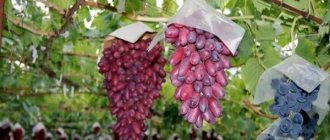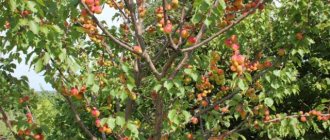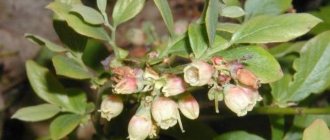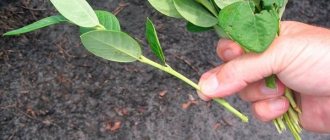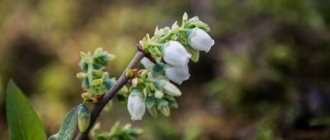About 6 years ago we decided to start growing such a healthy berry as blueberries at our dacha. The choice fell on the “Spartan” variety. We started getting really large and high-quality berries in the 5th year. The culture must receive very good care. You need to know a lot of necessary information, only then can you grow a really good harvest.
I didn’t succeed the first time; I had to work on the composition of the soil, which was not very suitable for growing blueberries. I want to share my experience of what needs to be considered, how to care for and grow Spartan blueberries.
Blueberries of the “Spartan” variety - tasty and healthy
This variety is not new to gardening. Blueberries have recently begun to be actively grown not industrially, but privately in summer cottages. After all, it’s much more pleasant to pick your own berries and put them on the table. Let's consider what characteristics this culture has.
History of origin
- This variety was bred in America. Breeders used varieties of blueberries that grow wild in northern America, in swampy areas.
- Spartan blueberries became known to a wide range of gardeners in 1956, but commercial cultivation began only in 1977.
- In Russia and the CIS countries they learned about the variety even later - in the 90s of the 20th century. The taste characteristics and the ability to get a harvest fairly quickly are valued by plant growers, and with proper care of the plants there are no particular difficulties at all.
Botanical description of the bush
- Blueberries of the “Spartan” variety are considered a deciduous and perennial plant. Its crown stretches up to 1.5 - 2 m, which makes it possible to call the variety tall. The crown is spreading and has a raised structure.
- The branches of the bush are erect, rigid, strong and elastic. The foliage is dark green, rich in color, elongated in shape, with a pointed tip. The edges of the leaves can be smooth, but sometimes have jagged edges.
- In the summer season, the elliptical-shaped leaves are a bright green shade with a slight reddish color, but in the autumn months they change color to crimson. Blueberry bushes are beginning to serve as decoration for any summer cottage.
- During the flowering period, buds form along the entire length of the branches. The flowers are concentrated on the upper part of the shoot. The shrub reaches its greatest growth and development at 4–5 years of age.
- The root system has a superficial fibrous structure, growing in depth to a maximum of 40 - 50 cm. Also, the root processes branch quite strongly, so this must be taken into account when planting.
- The plant is resistant to cold weather and can withstand frosts down to -28 degrees. Blueberries tolerate well when the branches die and freeze, and the berries mummify. Reproduction occurs rather slowly, since the branches do not grow quickly either.
- The Spartan variety is classified as a mid-early variety; the first harvest can be obtained already in the second ten days of July.
Description of berries
At the stage of technical ripeness, the berries acquire a rich blue-blue tint. Covered with a waxy coating. They are formed on elongated legs, the upper part is slightly flattened. The skin is dense. This allows the crop to be transported over long distances, which is good for those who grow blueberries for sale.
You may notice a small scar. The berries are collected in small loose clusters. The size of one medium berry is 1.6 - 1.8 cm. The taste is very pleasant, sweet, with a slight characteristic sourness and tartness. By the third wave of harvesting, the diameter of the fruit becomes slightly smaller.
The largest berries ripen in 5-6 years. This is when you can get the highest quality harvest. But for this it is necessary to prune the shoots. The berries are collected at least once every 7 days, since after ripening they begin to fall off.
Many gardeners praise the variety for its excellent yield. With proper cultivation, one bush can produce 4.5 - 6 kg of healthy, tasty and aromatic berries. There are 3 harvest waves in total, the most successful are 1 - 2. The last approach is characterized by smaller berries.
The use of fruits is universal. They have unique healing properties; they contain a lot of vitamins and minerals and beneficial substances. It can be used fresh for food, as well as making teas, infusions, and even baking pies. This berry can boost immunity and cure many ailments.
Growing technology
In order to get an excellent harvest for many years, you need to take into account all the nuances, and at first take very good care of the young bushes. Preparatory activities are also important.
Selecting a location
- Seedlings should not be planted in swampy areas or in lowlands where melt water may accumulate. It is also undesirable to plant blueberries in areas where groundwater flows too close to the soil surface. Stagnation of moisture in the root system can lead to a slowdown in the growth and development of the crop. The taste characteristics of the fruit will also suffer.
- The most comfortable area will be an open area, where there will be a lot of sun. In some cases, you can plant bushes in areas where there is partial shade, but in this case the sugar content of the berries will decrease and the growth of the bushes will not be rapid.
- When growing blueberries, you need to know one rule: do not plant seedlings in an area where other cultivated plants previously grew. Young bushes may not take root or may grow very poorly and become sick.
- Since the variety is tall, choose a place where there will be no drafts or cold winds. This will negatively affect the ripening of berries.
Soil composition and site preparation
This plant will grow well if the soil is light and acidic. Some gardeners make a mistake when, in an effort to achieve the desired level of acidity, they add vinegar, citric acid or an electrolyte to the soil. With the help of such actions, very significant damage is caused to the soil: the necessary enzymes and microelements are washed out, and the composition is disrupted.
In order for blueberries to take root after planting and adapt, and the composition of the nutrient soil mixture to meet the requirements of the plant, you need to add peat, which maintains the desired pH, and at the same time forms a humus colloidal complex. At the same time, the soil microflora and enzyme composition remain unchanged, the nutrients remain in place.
The crop will not grow on heavy soils, and you will not get a full-fledged plant. Loams and peat-based soils are the best, and don’t forget about soil aeration. If you are just starting out as a gardener, then it would be wiser to take the soil to the laboratory to analyze its composition. After all, planted in the right soil, the bush will not require much attention later.
Highbush blueberry Spartan - planting
Step #1. Choosing a place to plant Spartan blueberries
In order to collect up to 6 kg of delicious blueberries from one bush in the future, you need to take care of choosing the right place to plant them. Let's consider the basic requirements of the tall Spartan blueberry for its place of growth:
- The site for planting blueberries of the Spartan variety should not be low, clayey or swampy. Constant stagnation of moisture at the roots of the plant will negatively affect its growth and the taste characteristics of the berries;
- Choose a fairly sunny area for planting. It is in such a place that blueberries will be especially tasty. You can also plant in partial shade, but be prepared for slower growth of the bush, reduced yield, and a decrease in the concentration of sugars in the berries;
- When choosing a place to plant highbush blueberries of the Spartan variety, keep in mind that blueberries prefer to grow in places where no other cultivated plants have grown before. Blueberry bushes on cultivated soils will grow poorly and may even die;
- The place for planting highbush blueberries of the Spartan variety, as well as for other varieties of highbush blueberries, should be well protected from the wind. Winds become especially dangerous in winter.
Step #2. Preparing the soil for planting Spartan blueberries
The soil for growing Spartan highbush blueberries should be light and acidic. The shrub's root system is weak and rather superficial, which makes it difficult, or completely impossible, to grow blueberries on heavy clay soils. The Spartan variety grows remarkably well on peat soils and loams. Another important characteristic that the soil for growing Spartan blueberries must have is breathability. The soil should be loose and light to ensure good air exchange for the root system. If you are a novice gardener and are having difficulty determining the exact characteristics of the soil on your site, then it is better to take a soil sample to a special laboratory. If you choose the optimal location for planting Spartan blueberries, the blueberry will require virtually no care. How to properly prepare a site for planting Spartan blueberries? Let's consider the main recommendations:
- It is advisable to start preparing the site 14 days before planting;
- If you want to plant several bushes at the same time, then you need to take care of their location. It is best to plant blueberries in rows in a north-south direction. With this planting scheme, the plants will receive the maximum possible amount of sunlight;
- the distance between rows of tall blueberries of the Spartan variety can be from 1.5 m to 3 m. The distance between plants in a row should be about 0.8-1 m;
- After marking the site, you can begin preparing the planting holes. If the soil on the site is light and groundwater flows at a depth of more than 2 m, then the approximate size of the planting hole is 60 cm in diameter and 40 cm in depth. If the soil is heavy and clayey, then the planting holes are made wider in diameter and shallower (15-20 cm deep). If there is no other place for planting high-growing Spartan blueberries, except for a place with heavy and clay soil, then it is recommended to plant “on the ridge”. To do this, dig a hole 10 cm deep and fill it with a mixture of peat, sand, sawdust, building a hill. In the center of this hill the Spartan blueberry seedling lands;
- if a solid layer begins in a sandy area at a depth of about 0.5 m, then you need to make drainage or a kind of channel to remove excess moisture from the root system;
- The soil pH for successful cultivation of highbush blueberries of the Spartan variety should be from 3.5 to 5. If the soil is not acidic enough, then sulfur, sulfuric acid, and an acidic substrate (a mixture of peat, pine needles, sand) are added to it;
- if the peat in the area for planting Spartan blueberries is too acidic, then you can add 2-3 buckets of sand per 1 sq.m;
- Spartan blueberries may well grow in an area that has not been fertilized at all. If the land is particularly poor in nutrients, then nitrogen, potassium, and phosphorus fertilizers can be applied in a 1:1:1 ratio. If there is a lot of humus in the soil, then potassium, phosphorus, and nitrogen fertilizers are applied in a ratio of 3:2:1.
Step #3. Choosing planting material for blueberry Spartan
When choosing planting material for growing tall blueberries of the Spartan variety, it is better to give preference to 2-year-old or 3-year-old seedlings with a closed root system. A closed root system means that the seedling is placed in a plastic pot. Buying such seedlings is very convenient, since there is no need to rush with planting. If you have not yet started preparing the site for planting blueberries, then the seedlings can easily wait. Just remember to water them periodically. The seedling also requires a little preparation before planting. You need to immerse the pot in water for about 15 minutes. This is necessary so that the earthen ball is saturated with moisture. Carefully remove the blueberries from the pot and inspect the root system. It happens that blueberry roots are very tightly entwined in a ball of earth. In this case, you need to straighten them with your hands. If this is not done, then after planting the roots will not be able to “break through” the dense earthen lump, and the plant will die.
Step #4. Planting blueberries Spartan
- It is better to start planting highbush blueberries of the Spartan variety in the spring so that the plant has time to take root before the onset of frost.
- Remove the blueberry seedling from the pot after dipping it in water for 15 minutes. Spread out its roots.
- Place the seedling in the prepared planting hole and begin to cover it with soil. During the planting process, it is very important to shake the seedling slightly so that the soil fills all the voids between the roots.
- Next, you need to build a hole around the bush and water into this hole.
- Mulching is a prerequisite for planting highbush blueberries. The hole is covered with a layer of mulch of 5-6 cm.
Care Tips
- The bushes need to be watered regularly. It is especially important in the summer at least several times a week. Otherwise, if there is a lack of moisture, the taste of the berries will be much worse. For 1 bush you need 10 liters of water in the morning and evening on hot days, but you can’t overwater blueberries either.
- It is not necessary to apply fertilizer to an adult bush if you have enriched the soil well when planting. Fresh manure and mullein droppings are completely unnecessary for blueberries. Mineral fertilizers are applied: 2 years to the bush - 1 tbsp. l., 3 g. - 2 tbsp. l., 4 g. - 4 tbsp. l., 5 g. - 8 tbsp. l., 6 g. - 16 tbsp. l.
- Pruning is a must. The main goal is to shape the appearance of axial shoots.
Spartan blueberries are known for their beneficial properties. This variety grows successfully in many areas and is valued for its high level of fruiting and pleasant taste.
Highbush blueberry Spartan - care
Watering blueberries Spartan
Highbush Spartan blueberries require regular watering. It is especially important to follow the watering regime in the summer, when the berries begin to ripen and flower buds begin to form. If the plant experiences a lack of moisture during this crucial period, the harvest will be poor not only this year, but also in the future. When blueberries grow in a summer cottage, the plant needs to be watered 2 times a week. One adult plant will need 1 bucket of water in the morning and evening. It is also impossible to overwater the plant. Stagnation of moisture at the roots of blueberries for 2 days can completely destroy the plant. Some gardeners also practice spraying Spartan highbush blueberry bushes during periods of extreme heat.
Mulching blueberries Spartan
Mulching and periodic loosening of the soil are also very necessary for Spartan highbush blueberry bushes. The mulch layer can vary from 2 to 10 cm. Pine needles, straw, rotted leaves or sawdust are suitable for this. Some gardeners note the fact that after mulching, young bushes grow at a slower pace. This can be explained by the fact that various microorganisms from the soil begin to intensively decompose the fresh layer of mulch and at the same time “pull” useful nitrogen elements from the soil. This problem can be avoided by adding additional nitrogen fertilizer. This can be done both before and after mulching. Loosen the soil around the blueberries very carefully so as not to damage the root system. It’s also not worth doing this too often, as you can dry out the bush.
Fertilizing blueberries Spartan
Under natural growing conditions, highbush blueberries do not require rich and nutritious soils. It grows without problems in scanty areas, giving a large harvest. If you grow Spartan blueberries in your summer cottage, you can influence the yield of blueberries by applying mineral fertilizers. You can purchase such fertilizers in specialized stores (complex fertilizers for heathers, conifers, rhododendrons). It is best to start feeding blueberries in the spring, the period before the buds swell. You can follow the following scheme for applying complex mineral fertilizer:
- 2-year-old blueberry bush - 1 tbsp of complex mineral fertilizer;
- 3-year-old blueberry bush - 2 tbsp. complex mineral fertilizer;
- 4-year-old blueberry bush - 4 tbsp. complex mineral fertilizer;
- 5-year-old blueberry bush - 8 tbsp. complex mineral fertilizer;
- 6-year-old blueberry bush and older bushes - 16 tbsp. complex mineral fertilizer.
It is also worth noting that high-growing Spartan blueberries in a summer cottage do not require any organic fertilizers (manure, humus, chicken droppings).
Pruning blueberries Spartan
Young Spartan blueberry bushes under 4 years old need sanitary pruning. Bushes older than 3-4 years can begin to be pruned. Since the bushes have a rather spreading shape, they begin to trim the lateral hanging branches, and then the central ones. The main goal of pruning highbush blueberries is to form as many axial branches as possible. The strength of pruning of Spartan highbush blueberries affects the nature of the crop. The weaker the pruning, the larger the harvest will be, but the berries will be smaller. If the pruning is more severe, the berries will be large, but their number will be smaller. When pruning Spartan blueberries, you can be guided by the following principles:
- weak sanitary pruning consists of removing dead and damaged branches, removing old shoots that do not produce new growth. Also, such pruning involves the removal of shoots that are located near the very surface of the earth. In this case, even fruit-bearing branches are removed;
- starting from the 4th year of life of the Spartan blueberry, spreading shoots at the soil surface are annually removed, erect shoots are left. You also need to avoid thickening the bush by removing old and weakened shoots.
Description of blueberry variety Spartan
The plant is a perennial shrub, the height of which varies from 1.5 to 2 m. It is characterized by the presence of erect and strong stems. Their maximum length is 2 m.
According to the description and photo of the variety, Spartan blueberries have simple, oblong leaf blades with smooth or jagged edges, and a dark green hue. In spring, the shrub is covered with bright green foliage, which changes color to red in autumn, which gives the plant a decorative appearance.
The root system is of the fibrous type: it branches well, spreads to a depth of 40 cm. It begins its development in the spring, after the soil warms up, then the growth of the shrub stops and resumes in September-October. In bad weather conditions, the plant is able to slow down all processes until the temperature stabilizes.
The buds of the blueberry variety are located along the entire length of the shoots, but flowers, in the amount of 5-10 pieces, are formed at the ends of the branches.
Description of berries
Highbush blueberries Spartan are classified as mid-early varieties in terms of ripening time. The first ripe berries appear at the end of July.
The round-shaped fruits are characterized by a dense light blue skin and juicy pulp. The average weight of one berry reaches 1.6 g.
The fruits are slightly sour and have a very pronounced pleasant aroma. In terms of taste, the Spartan variety is rated at 4.3 points.
Blueberry Spartan - reviews
- Irina R. “I only recently learned about the possibility of growing blueberries at the dacha. For my first experience, I chose the Spartan variety. The seedlings have taken root well. She collected her first harvest 4 years after planting. I have never regretted my decision to grow a tall variety. Blueberries Spartan, in my opinion, are completely unpretentious. My care consists of watering and periodic pruning.”
- Valery P. “The highbush blueberry variety Spartan settled on my plot about 7 years ago. I also grow other varieties of blueberries, so I have something to compare with. Although the variety is not very frost-resistant, it tolerates winters well in our region. I collect about 5 kg of blueberries from one bush. Most of the berries are consumed fresh, some are sent for sale. The berries keep well in the refrigerator.”
In order to harvest tasty and healthy blueberries, you don’t need much. You are required to choose the right place to plant blueberries, prepare the soil, water and get rid of weeds. The Spartan variety will surprise you with its yield and excellent taste of the berries.
Characteristics of the variety
Under natural conditions, blueberries grow successfully in Siberia and the Urals and are valued among the population for their beneficial properties. The Spartan variety, obtained by breeders, is distinguished by higher frost resistance and yield, and immunity to diseases and pests.
Main advantages
According to reviews, the Spartan blueberry variety is known for its frost resistance (up to -28 ° C); under the cover of snow, the bushes remain intact.
The plant is not picky about care, but grows well in acidified soils and requires proper watering. Excess moisture negatively affects blueberry yields.
Ripe berries are perfectly stored; they are transported over long distances in specialized containers with temperature regulators.
Flowering period, ripening time, yield
The flowering period varies depending on climatic conditions and the region of cultivation. Often the first buds appear in the first half of June and tolerate spring frosts well.
According to the description of Spartan blueberries, the first harvest can be harvested in late July or early August. Fruiting lasts 2.5-3 weeks, during which time the light blue berries are picked 3-5 times.
The largest and most visually attractive blueberries ripen in the 1st and 2nd approach, after which the harvest becomes less abundant. 4.5-6 kg of berries are harvested from one bush.
Area of application of berries
Reviews of Spartan blueberries confirm the versatility of the fruit; it is grown for personal use (making vitamin teas, culinary dishes). Due to its beneficial properties, the berry is added to healing decoctions, mixtures and infusions are made.
Resistance to diseases and pests
Blueberry Spartan is immune to moniliosis, shoot dieback. The berries of this variety do not mummify. But in the absence of preventive measures, the risk of pest attack is high.
Advantages and disadvantages of the variety
Assessing the strengths and weaknesses of a plant is the surest way to choose a successful seedling for your garden.
- self-fertility;
- possibility of long-term storage and movement over long distances;
- pleasant aroma and taste
- immunity to diseases.
Planting and caring for Spartan blueberries
Monitoring soil quality and organizing proper care can ensure stable high yields. Before planting Spartan blueberries, it is important to decide on a seedling and choose a site in the garden.
The variety is transferred to open ground both in autumn and spring. A seedling planted after the snow melts has time to take root over the summer and prepare for the winter cold, so it is planted before buds appear on the trees.
Under the bush, it is necessary to allocate an area inaccessible to the wind and well illuminated by the sun's rays. The soil should not be waterlogged: the Spartan variety does not tolerate excess water, which affects blueberry growth and fruiting.
The optimal pH for berries varies from 4 to 5. To acidify the soil, peat, sand, sawdust or pine needles are added to the pit with soil. If necessary, it is possible to use chemicals while cultivating the plant.
Spartan blueberry seedlings should be purchased from specialized nurseries or centers. The plant must have a closed root system; the bush is placed in a container with ventilation.
Algorithm for transferring a seedling to open ground:
- Prepare a hole with a depth of 50 cm and a diameter of 60 cm. A distance of 1 m is maintained between the bushes.
- A layer of crushed stone and substrate is placed at the bottom.
- The plant is transferred to a hole, the roots are straightened and covered with soil.
- Water the blueberries and mulch the ground around with straw or bark.
Subsequent care of the crop
An important stage of agricultural technology is watering. The soil should not dry out, but also not be waterlogged. To reduce the number of waterings, the soil is mulched to 5-8 mm with sawdust.
In the spring, it is necessary to apply mineral fertilizers to the shrub, which include nitrogen, potassium and phosphorus. To maintain an acidic environment in the soil, blueberries of the Spartan variety are watered every 10 days with a solution of colloidal sulfur. You can replace the solution with potassium or ammonia sulfate, nitroammophos, or urea.
Pruning blueberries of the Spartan variety is carried out 6 years from the date of planting. To do this, remove old branches and shoots at the roots, leaving 3-5 large shoots on the bush. The optimal time for carrying out the procedure is late autumn or early spring.
Preparing blueberries for winter
It is important to prepare the shrub for winter frosts after planting and seasonally caring for Spartan blueberries. In the Moscow region, the variety tolerates low temperatures well without shelter, but in colder regions, seedlings are wrapped in spruce branches or agrofibre, or snow.
Subsequent care of the crop
To obtain a high yield, blueberries are provided with constant care. Be sure to regulate watering, apply fertilizers, and prune the bush.
Necessary activities
When growing Spartan blueberries, water them moderately; the soil should not dry out or contain too much moisture. Mulching the soil with sawdust helps reduce the number of waterings. The optimal layer of mulch is from 5 to 8 mm.
In spring, blueberries are fed with mineral complexes containing nitrogen, phosphorus and potassium. Every 10 days, to acidify the soil, the bushes are watered with a solution of colloidal sulfur.
Important! Blueberries are not fertilized with organic matter.
Loosening the soil ensures the supply of oxygen and nutrients to the roots. As a result, the growth and productivity of bushes improves.
Shrub pruning
Blueberries over 6 years old require pruning. At the bottom of the bush, shoots are removed. Branches older than 6 years are also cut out. From 3 to 5 largest shoots are left per bush.
Pruning allows you to rejuvenate the bush and increase its productivity. The procedure is carried out in late autumn after leaf fall or in spring before the beginning of the growing season.
Preparing for winter
With proper planting and care of Spartan blueberries in the Moscow region, the bushes tolerate winters well without shelter. In autumn, 100 g of superphosphate is applied under the plant.
Young seedlings are insulated using agrofibre and spruce branches. In winter, snow is thrown over the bush.
Disease and pest control
One disease that can damage blueberries is powdery mildew. It is characterized by the appearance of yellow spots on the leaf blades, which gradually wrinkle and fall off. Topaz is used to treat powdery mildew.
Brown spots spreading across the leaf blade are rust. To get rid of it, Bordeaux mixture and fungicides are used. Without timely treatment, the foliage falls, which can lead to the death of Spartan blueberries.
As preventive measures, it is important to timely prune the bush, apply fertilizing, and use fungicidal preparations in autumn and spring.
A common pest of Spartan blueberries is aphids. It damages leaf blades, which, as it spreads, curl, turn yellow and fall off. As a result of the pest's activity, the yield of the bush decreases.
To combat aphids on Spartan blueberries, use the drug Aktar or Calypso 480 SC.
The bud mite negatively affects the yield of the variety. The pest not only sucks moisture from the leaf blades, but also destroys the buds. To combat mites, use a solution of iron sulfate or the drug Nitrafen.
To prevent pest attacks, it is important to choose a healthy seedling and follow the rules of agricultural technology: dig up the soil, destroy fallen leaves and pruned shoots.
Diseases and pests, methods of control and prevention
The most dangerous blueberry diseases are shown in the table:
| Disease | Symptoms | Treatment methods | Prevention |
| Powdery mildew | Yellowish spots on the leaves; over time, the leaf blade becomes wrinkled. | Spraying with Fundazol or Topaz. |
|
| Rust | Brown spots on leaves. Gradually the foliage turns yellow and falls prematurely. | Treatment of bushes with Bordeaux mixture or Abiga-Pik fungicide. |
Common crop pests are listed in the table:
| Pest | Description of the lesion | Ways to fight | Prevention |
| Aphid | Leaves curl and fall, fruits become smaller. | Treatment with Aktara. |
|
| Kidney mite | The pest eats away the buds and sucks the juice from the leaves. | Spraying the bush with Nitrafen or iron sulfate. |
History of selection
There are many varieties of blueberries. Among the varieties, it is worth noting the Spartan variety, which was selected in 1956. It has been widely used in gardening since 1978.
Description of the variety
North America is considered the birthplace of the berry. The variety is unpretentious to its location, grows and bears fruit well, especially in peaty, swampy and rocky areas. It is widely used by gardeners, since proper care practically guarantees high yields, and therefore income for the entrepreneur. Absolutely anyone can plant bushes in their garden and get fresh berries in season.
Berries
The berries of the crop are large, deep blue (blue sapphire). Each fruit has a velvety coating. The bush bears fruit in small clusters. The shape of the berry is round, slightly flattened. It is great for shipping because it has a thick skin and a meaty center. Blueberry fruits have a tart-sweet taste with a hint of sourness.
The size of one berry reaches up to 18 mm, the approximate weight is 2 g. From one bush you can harvest up to 6 kg of crop, which is a lot. At the same time, proper care of the plant is important - fertilizing the soil and pruning.
Leaves
The bush of the plant is completely covered with leaves. Their color can be reddish at first or deep green when the fruit ripens. The leaves are large in size, elliptical in shape, with jagged or even edges.
Characteristic
The main characteristic of the plant is its frost resistance. The culture can easily withstand sub-zero temperatures down to -28°C. As for the mummification of berries or the death of shoots, this practically does not happen with the Spartan variety.
Flowering period and ripening time
Blueberries of this variety are extremely tasty and healthy. It blooms in late spring, which practically guarantees good yield, since the peduncle will not be damaged by spring frosts. The bush begins to bear fruit in July. In the midst of summer, every gardener who has at least one bush will be able to enjoy sweet fruits on the table.
Landing rules
There are practically no particularities in planting the plant. You just have to choose a place with an acidic soil composition. The Moscow region is considered one of the most optimal regions for planting. A moderate microclimate, swampy peat soil, and coniferous forest soil are the main conditions for normal blueberry growth.
When planting, the choice of soil is important; it must be acidic (at least 3.5-4 pH). To determine acidity, it is worth paying attention to what plants grow in the area. If there is sorrel and horsetail, then they indicate acidic soil. You can also buy a tester to determine acidity (pH meter).
There are several stages of planting:
- Blueberries should be planted in warm soil in late spring. Seedlings with a closed root system are used.
- The planting site should be well lit by the sun and protected from the wind; the soil should be acidic. If the soil acidity is insufficient, watering with the addition of citric acid is used.
- In the Moscow region, bushes should be planted separately from each other at a distance of 1.0–1.5 m in not very deep trenches, holes or ridges. The selection of seedlings is also important - you need to choose plants in containers.
- The distance between the bushes should be (from 50 cm to 140) 50–140 cm, the depth of the hole should be up to 50 cm.
Video: planting Spartan blueberries
Shrub pruning
A true patriotic gardener certainly knows all the intricacies of growing blueberries. Pruning shrubs is as important as planting them. It is best to carry it out in late autumn, after the leaves have completely fallen off, or in early spring before buds begin to form.
The main difference between blueberries and other plants of this species is that pruning does not need to be done often. It is enough to cut off all the old branches and lower shoots once every 6 years, leaving about 6 of the healthiest shoots. Such pruning of the bush will only increase its fruiting and productivity.
Landing
Blueberry seedlings are purchased only in special containers and from trusted distributors. Planting can be open or closed, carried out in pre-prepared soil. Before planting with bare roots, they need to be dipped in water for 15 minutes.
After this, carry out the landing in four stages:
- Dig holes 50 cm deep and 60 cm in diameter at a distance of 1 m from each other.
- The bottom of each pit must be laid with pebbles or crushed stone, on top of which a mound of previously prepared substrate (30% high peat and 30% humus) must be poured.
- Plant on the formed hill, lay it on it and straighten the roots of the plant.
- When planting, seedlings must be buried in the soil to a depth of 5–8 cm.
- Afterwards, water all the seedlings generously and mulch with a 5-centimeter layer of bark, peat or straw.
Blueberry planting algorithm
Before planting blueberries, prepare the seedlings, pits, and fertilize the soil. Work must be done within a certain time frame, taking into account a suitable location. After planting, mulch the area around the bush. The variety does not require special planting technologies; it is only important to follow the rules.
Recommended dates for planting
It is better to do planting work in March, before the sap flows. Then the seedling will have time to take root before frost. In the South, the crop can be planted in the fall if the air temperature is above 10 degrees Celsius. In the northern regions and central zone, it is advisable to plant the berries in the spring, since severe frosts will destroy the young seedling.
Deciding on a place to plant blueberries
In order to collect 6 kg of crop from a bush in the future, you need to worry about choosing the right place on the plot.
- The site should not be low, clayey, or swampy. Constant stagnation of water at the rhizome is fraught with inhibition of their growth and deterioration in the taste of the fruit.
- The place should be well lit; blueberries love sunlight. Then the berries will be more tasty. It is also possible to plant a bush in partial shade, but its growth will slow down, the yield and the concentration of sugars in the berries will decrease.
- Blueberries do not like to “live” in places where other crops used to live. The bushes may die or grow poorly.
- The planting site should be well protected from drafts; winds are especially dangerous in winter.
You should not plant blueberries next to trees, they will block the sun's rays.
Preparing the soil and pit
Blueberries prefer to grow in humus-rich, light soils with an acidity level of pH 3.5-4.5. There should be a distance of 1.5 meters between the bushes, and 2.5-3 between the rows. For industrial purposes, a different crop cultivation scheme is practiced. The distance between shrubs is 1 meter, and 2.5 between the beds.
The hole is filled with an organic mixture consisting of 30% humus, 30% high peat. The rest includes rotted litter of pine forest, pine needles, bark, and river sand. The planting material is taken out of the container and the rhizome is straightened. It should not be gathered into a ball or bent.
The seedling is immersed in the ground 2-3 cm deeper than it grew in the container and watered. The tree trunk circumference is mulched with peat, rotted bark, and needles. The layer creates nutrition for the mycorrhiza, the crop itself, and keeps the soil loose and moist from drying out.
Preparing seedlings
When choosing a seedling, you should pay attention to 2-year-old specimens with a closed rhizome. This seedling is located in a pot. It’s convenient to buy them because you don’t have to rush with planting work. If planting is delayed, water the seedlings with settled water.
Before planting, prepare the material in this way:
- place in a clay mash for 15 minutes;
- Remove the blueberries from the container, inspect the rhizome, and straighten them with your hands.
If you ignore the last point, the roots may not break through the dense earthen ball and die.
Technology and planting scheme
Spartan blueberries should be grown according to the following rules:
- dig a hole in the plot with a diameter of 60 and 50 cm deep;
- Pour a drainage layer of crushed stone and pebbles onto the bottom of the hole, place the prepared substrate on top to form a mound;
- carefully plant the seedling on a hill, straightening the root system and covering it with soil;
Water the planting material, cover the ground with peat, straw and bark in a 5 cm layer.
Diseases and pests
The most common crop diseases are rust and powdery mildew. It is quite possible to avoid this if you do not water the plant often, care for and prune it on time, and also spray it with a specially designed fungicide, for example Topsin-M, in early spring.
Common pests include bud mites and aphids. Their occurrence can be prevented with the help of an insecticide such as Actofit, which is used to spray the crop once from spring before the fruiting season or in late autumn after harvesting. Also, after leaf fall, you should burn all the leaves and dig up the soil near the bush.
Care Tips
If you constantly monitor the plant, spray it against diseases and pests, and trim it on time, then the harvest will be good. It is also necessary to periodically feed the soil with nitrogen fertilizers, as well as those containing sulfates and calcium, for example Fertika-universal - NPK. Nitrate options are not used.
There are two ways to regulate soil acidity:
- If the pH is below 3.5, then urea is used;
- If the pH is above 4 - potassium or ammonium sulfate, or superphosphate;
- In winter, each bush needs to be insulated; this will prevent the roots and pagons from freezing. The plant is frost-resistant, but still, when it gets cold, each seedling will need to be wrapped in snow, agrofibre or spruce branches.
Growing berries at home is not difficult, especially if the gardener knows all the intricacies of the necessary care. The recommendations presented will help you figure out what and how to do in order to collect a certain number of berries during the season.
Planting and further care
The planting hole for blueberries should have dimensions of 50x50x50 cm. The bottom is covered with a drainage layer. For this purpose, you can use crushed stone or pebbles. Pre-prepared soil is poured onto the drainage in a mound. The seedling is carefully placed on a mound, the roots are evenly distributed and covered with soil.
When planting several seedlings, maintain an interval of 1.5 m. If you plan to plant several rows of blueberries, leave a distance of about 3 m between them.
After planting, the soil in the tree trunk circle must be watered. Then each seedling is mulched with peat, rotted bark or pine litter. Gradually decomposing, the mulch will begin to nourish the plants, additionally providing the necessary acidity of the soil. Blueberries will not grow in alkaline soil, since its roots absorb nutrients only in symbiosis with mycorrhiza. A special fungus can only exist in an acidic environment.
Blueberry care includes:
- watering 2 times a week (for one adult bush - 10 liters of water) in the morning or evening;
- periodically replacing mulch (usually in spring and autumn);
- applying fertilizers in the form of mineral complexes (there are specialized fertilizers for blueberries);
- pruning (up to 4 years is carried out for sanitary purposes, then you can form a bush and remove the lower spreading branches);
- preventive spraying in early spring and autumn with a 2% solution of copper sulfate.
Due to the frost resistance of the variety, the shrub does not need shelter for the winter. Blueberries easily tolerate temperature drops down to -30 °C. Bushes should be insulated with agrofibre only in harsh climates or during snowless winters. Seedlings that overwinter for the first year must be additionally covered with snow.
Due to its characteristics, blueberries of the “Spartan” variety can be successfully grown in central Russia and more northern regions. The shrub does not require special wintering or careful care. To obtain abundant harvests, you need to plant blueberries in a well-lit place and maintain the required level of soil acidity.

